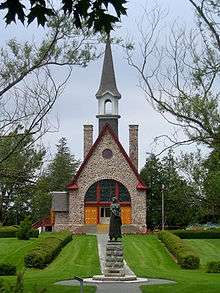René-Arthur Fréchet
| René-Arthur Fréchet | |
|---|---|
 Memorial Church in Grand Pré (1910) | |
| Born |
1879 Montreal, Quebec |
| Died |
1950 Moncton, New Brunswick |
| Nationality | Canadian |
| Alma mater | Laval University |
| Occupation | Architect |
| Practice | Religious and domestic |
| Buildings | Memorial Church in Grand Pré (1910) |
| Projects | Numerous churches in New Brunswick and Nova Scotia, Capitol Theatre, Moncton |
René-Arthur Fréchet (June 6, 1879 - May 28, 1950) was a Canadian architect who was active in New Brunswick and Nova Scotia, modern day Acadia.
Life
Born in Montreal, Fréchet obtained a degree in architecture from Laval University in 1898 and the same year he obtained a job with the Intercolonial Railway as an architect. Two years later, in 1900, he moved to Moncton for the railway, and resided at the Minto Hotel. In 1905, he opened his own architecture firm, developing a specialty in religious and domestic architecture.[1] However, he was not limited to these architectural fields. Notably, he designed the Capitol Theater in Moncton in the mid-1920s.[2]


Fréchet became involved in the Acadian community. In 1903, he married Elvina Cormier, daughter of a local merchant, Simon Cormier. He was a member of the provisional management team for the French language Acadian newspaper L'Évangéline, a founding member of the revitalized newspaper (1920s, see Valentin Landry), a municipal councilor in Moncton for several years, and a member of Société Nationale l'Assomption.[1]
René-Arthur Fréchet died on May 28, 1950 in Moncton. Two days later, Émery Leblanc published a letter in L'Évangéline in memory of Frechet, highlighting his accomplishments.[3]
Works
In Moncton:[4]
- Mary's Home
- Provincial Bank of Canada
- Brunswick Hotel (now Crowne Plaza significantly altered)
- Capitol Theatre
- Academy of the Sacred Heart
- St. Bernard's Roman Catholic Church
- Hôtel-Dieu and nurses residence
- Good Shepherd Sisters Building (now the Léopold-Taillon Building, University of Moncton)
Elsewhere in New Brunswick:
- Saint-Antoine l'Ermite Church, Saint-Antoine
- St. Joseph's Church, Shediac
- Léger Pharmacy, Shediac
- Church of St. Francis Xavier, Charlo
- 21 Gray Street, Fredericton
- John Peck House, Hillsborough
- Creaghan Building, Miramichi
- Church of St. John the Baptist and St. Joseph, Tracadie
- Bourgeois House, Tracadie
- Government of Canada Building, North Head
In Nova Scotia
- Memorial Church, Grand-Pré National Historic Site
- St. Bernard Church, St. Bernard, Nova Scotia
Legacy
In 2012, a park in the Sunny Brae neighbourhood of Moncton was named to recognize the legacy of René-Arthur-Fréchet. Fréchet had been virtually forgotten at the time of the park's naming, and in 2016 residents petitioned to have it given another name.[5][6] The publicity revitalized his memory.[7]
References
- 1 2 Regis Brun, The Acadians in Moncton, a century and a half of French presence at the Coude, Moncton, 1999, p. 83.
- ↑ Joan Mattie, "Theater Design to 1950", The Canadian Encyclopedia, 2006, Accessed February 7, 2017.
- ↑ Emery LeBlanc. "Mr. René Arthur Fréchet". L'Évangéline, May 30, 1950, accessed February 3, 1950.
- ↑ René-Arthur Fréchet, Biographical Dictionary of Architects in Canada 1800-1950
- ↑ Kashmala Fida, Moncton's Sunny Brae area choosing new name for park: People complained the current name didn't reflect the local history of the former town, CBC news, March 21, 2016. Accessed March 7, 2017
- ↑ City of Moncton, René-Arthur Fréchet Park, Accessed March 7, 2017
- ↑ In French: Editorial, "Qui était René-Arthur Fréchet?", L'Acadie Nouvelle, January 19, 2017. Accessed March 7, 2017
| Wikimedia Commons has media related to René-Arthur Fréchet. |